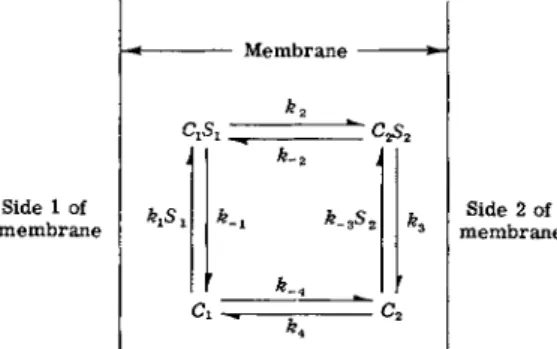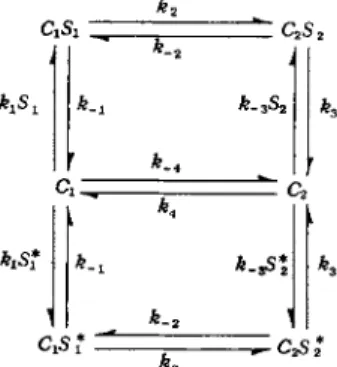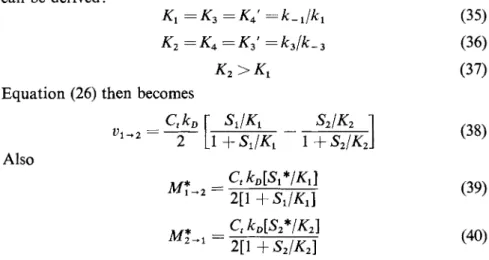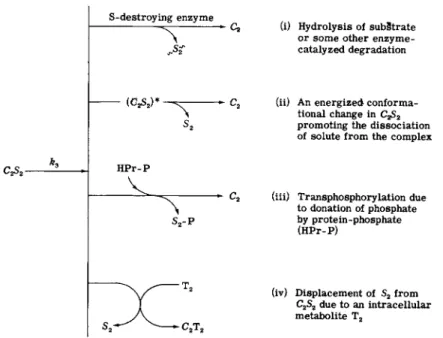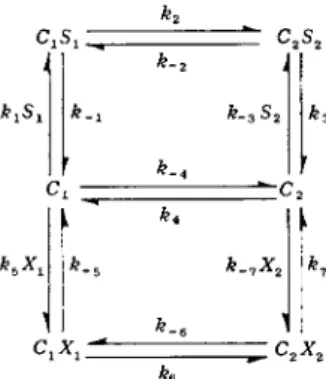CHAPTER 1
The Use of the Steady-State Assumption to Derive Kinetic Formulations for the Transport of a Solute across a Membrane
Harry Schachter
Glossary 1 I. Introduction 2 II. Rate Equations for the Monovalent Carrier Mechanism of Facilitated
Diffusion 4 A. The General Rate Equation 4
B. Unidirectional Flux Equations 6 C. Simplifying Assumptions 9 III. Active Transport Involving Monovalent Carrier 10
A. Simplifying Assumptions Applied to Active Transport Equations.. 12
B. Site of Energy Input in Active Transport 12 IV. Two Substrates Competing for the Same Site on a Monovalent Carrier 12
References 15
GLOSSARY
Cu C2 Concentration of free carrier on side 1 or 2 of membrane
Ct Concentration of all the carrier in the system, free and bound (i.e., total carrier concentra
tion)
k (with subscript) Rate constant
Κ (with subscript) A complex term containing several rate constants ΜΪ-.2 Unidirectional flux of labeled solute in direction
1 to 2
M*-.i Unidirectional flux of labeled solute in direction 2 to 1
ι
2 HARRY SCHACHTER
I. INTRODUCTION
The mechanisms by which a solute can be transported across a membrane barrier may be grouped into the following categories:
(1) simple or passive diffusion, (2) facilitated diffusion, and (3) active transport. Passive diffusion obeys Fick's first law of diffusion, which states that the rate of movement of a solute through a membrane barrier is directly proportional to the concentration gradient of solute across the membrane and to the area of the membrane; the propor- tionality constant is called the diffusion coefficient for transfer of the solute across that particular membrane. For a charged solute the diffusion rate is determined not only by the concentration gradient but also by the electrical potential across the membrane (see Chapter 2 in Stein [1] for a detailed discussion of Fick's law). According to Fick's law, therefore, the rate of movement of a solute across a barrier can be made more rapid merely by increasing the concentration gradient of the solute; this process cannot continue indefinitely but will be limited at very high concentration gradients by the solubility of the solute, by aggregation of solute molecules, and by other factors.
The concept of facilitated diffusion arose when it was found that many transport phenomena were not compatible with the predictions of the passive diffusion mechanism. For example, the rate of penetra- tion of solute may be proportional to the concentration gradient only at relatively low concentrations and may reach a limiting or saturation Su S2 Concentration of solute S on side 1 or 2 of
membrane
Si*, S2* Concentration of labeled molecules of S on side 1 or 2 of membrane
v^2 Net flux of solute across a membrane in direc- tion 1 to 2
v*^2 Net flux of labeled solute molecules across a membrane in direction 1 to 2
v\-.2 Net flux of solute S across a membrane in direc- tion 1 to 2 in the presence of another solute Xl9 X2 Concentration of solute X on side 1 or 2 of
membrane
Arrows A collection of arrows schematically represents a kappa product as described by Wong and Hanes [8]
1. TRANSPORT RATE EQUATIONS 3 level as the concentration is increased to values at which Fick's law should still be applicable. Other criteria for identifying facilitated diffu- sion systems are available (Chapter 4 in Stein [1]). The model usually in- voked to explain facilitated diffusion is the mobile carrier hypothesis in which the solute attaches to a membrane-bound carrier that shuttles back and forth between opposite faces of the membrane; thus the carrier picks up solute on one side of the membrane, deposits it on the other side, and then returns for more solute. In such a model the rate of movement of solute through the barrier reaches a saturation value as concentration of solute is increased because all the carrier in the system becomes bound to solute.
In the case of either passive or facilitated diffusion, net flux of solute across the barrier ceases when the concentration gradient becomes zero; in other words, these mechanisms do not permit movement of solute against a concentration gradient. The term active transport is generally used to refer to those mechanisms which do permit uphill transport of solute against a concentration gradient. Active transport mechanisms require the input of energy, and this energy can be derived from two general sources: (1) some type of energy-producing chemical reaction coupled to the transport process or (2) an electro- chemical gradient of a different solute across the barrier. The first type of system is called a primary active transport system since only a single solute is involved, whereas the systems in which an electro- chemical gradient of one solute drives the movement of another solute are called secondary active transport systems (see Chapter 6 in Stein [1]).
The role of kinetics in transport studies has been similar to the role of kinetics in the study of enzyme mechanisms. Experimental data are obtained, and kinetics are called into play in an attempt to correlate the data with a particular theoretical model. Many different rate equations for the transport process have been published [1-5]. Most of these equations are based on the carrier model for facilitated diffu- sion; the variety of equations arises because of the diverse assumptions used in the derivations. It is the main purpose of this chapter to derive the rate equations for facilitated diffusion and for active transport making only a single important assumption, namely that all inter- mediates involving carrier are in the steady state. The applicability of steady-state theory to enzyme kinetics has been established [6]; its use in transport kinetics is based on the similarities in function between enzymes and transport carriers.
The steady-state derivation of transport rate equations will be carried out by the determinant method of King and Altman [7]. These authors devised a set of schematic rules that allows us to write down the rate
4 HARRY SCHACHTER
equation of any given reaction mechanism by inspection of the mech
anism [8,9]. Since details of this method are not discussed here, the reader is referred to the paper by Wong and Hanes [8] for an explana
tion of the procedures for deriving the transport rate equations.
RATE EQUATIONS FOR THE M O N O V A L E NT CARRIER MECHANISM OF FACILITATED DIFFUSION
A. The General Rate Equation
The simplest model of the mobile carrier hypothesis for facilitated diffusion is shown in Fig. 1. The carrier is assumed to be monovalent, i.e., it carries only a single solute molecule at a single site on the carrier molecule. Polyvalent carriers are mentioned briefly in Section IV.
The total carrier concentration Ct is given by the equation
C, = Q + C2 + + C2S2 (1)
Using the schematic rules of King and Altman [7] as adapted by Wong and Hanes [8], it is possible to derive the following rate equation by inspection of the mechanism of Fig. 1.
c,[D-D]
(2) where Δ is a complex expression outlined in detail in Table I. By collecting terms from Table I, the expression Δ can be written as follows:Δ =(fc4 +k-4)(k.ik3 +k-ik-2 + k2k3) + ki(k2k3 + k3k4 +k.2k4
~t~k2k^Si -\-k-3(k-\k_2 -f~k-\k-4 -\-k-2k-\-k2k-^)S2 + klk-3(k2+k-2)S1S2
FIG. 1. Mobile carrier model for facilitated diffusion.
1. T R A N S P O R T R A T E E Q U A T I O N S 5
Paths to Ci Paths to C2 Paths to dSi Paths to C2 52
π π u c
c 3 c π
u U π •
3 C 3 u
k~ \k_2k_ 3S'2 k-ik-2k4.
k-ik3k4.
k2k3k4.
k\k,2 k$ S1
&2 k$ k-4.
k3k-!k-4.
k-ik-2k-4.
k ik3k^, S1 k\k$, k—2 Si k\k—2 k—3 S1S2 k-2k-3k-4.S2
k \k,2 k^. Si kik2 k _ 3 S1S2
^ 2 k—3 k—4.S2 k-ik-3k-4.S2
a The kappa products are derived by examination of the mechanism shown in Fig. 1 ; the schematic method of representing kappa products is explained fully by Wong and Hanes [ 8 ] .
Rate Eq. (2) gives the net flux of solute S in the direction from side 1 to side 2 of the membrane barrier assuming only that Cl9 C2, and C2 S2 are in the steady state.
Equation (2) can be written as follows.
Ct(klSik2 k3k4 k^lk-2 k-3 $2 k-4)
With facilitated diffusion, movement against a concentration gradient is impossible, and the net flux therefore becomes zero when St =S2. Substituting these conditions into Eq. (3) yields the relation
k\k2 /R3 k± = k-\k-2 k-^ k-± (4) From Eqs. (3) and (4) and from the expression for Δ shown in Table I,
it is possible by simple algebraic manipulations to derive the following general rate equation for facilitated diffusion.
kik") k'x ki
TABLE I
THE K I N G AND ALTMAN [7] DERIVATION OF EXPRESSION ΔΑ
6 HARRY SCHACHTER
where
K i = Γ p(k4 + k-4) j [kiikik3 -\- k3k^, -\-k-2k^ ~t~k2k±)\
K 2 = Γ ήΚ + k.A) j ^
\_k-${k-ik_2 ~\~k-ik-4 -f- k-2k~4 ~\~ k2k-^)]
= r f c . ^ . ^ + f e . J] = Γ k2k3(k4+k_4) 1
3 L * i*4( * 2 + k.2) J U-3 * -4( *2 + k.2)\ W
*
4 =[/U ^U
=fcfe]
(9)ρ = (k-1k3+k-lk„2+k2k3) (10)
Equation (5) can be rearranged as follows.
v _ Ct[k*k-J(kt + k-j\[(Si - S2)/K,]
^2 [1 + + S2/K2 + K } This is a most useful statement of the general rate equation because most of the expressions in common use can be derived from it by substituting simplifying assumptions; some examples of this are shown in Section II,C.
B. Unidirectional Flux Equations
Equation (11) gives an expression for the net flux of solute through the membrane barrier. The net flux is the difference between the rates of movement of solute from side 1 to side 2 and from side 2 to side 1.
It is possible to determine experimentally the unidirectional flux of a solute from one side of a membrane to the other by using isotopically labeled solute. The equations for unidirectional flux can be derived from the scheme shown in Fig. 2. In this model the transport of unlabeled solute molecules (S) is considered separately from the transport of labeled solute molecules (S*). Under the usual experimental conditions the amount of tracer used is extremely small relative to the amount of unlabeled molecules present; thus the following conditions can be assumed:
Sx > 5Ί*, S2 > S2*9 CxSt > C W , and C2S2 > C2 S2* The total carrier concentration is given by the expression
Ct = Cl + C2 + C.S, + CxSt* + C2S2 + C2S2*
1. TRANSPORT RATE EQUATIONS 7
FIG. 2. Monovalent carrier mechanism for facilitated diffusion of labeled (S*) and unlabeled (S) solute.
This expression simplifies to
Ct =• C\ -\- C2 ~\~ C\Si -\- C2 S2
under conditions where isotope is present in very small amounts; the latter equation is identical with Eq. (1).
Applying the schematic rules of King and Altman [7] to the model shown in Fig. 2, it is possible to write out by inspection the steady- state unidirectional flux equation for the movement of isotope from side 1 to side 2 as follows:
c [ U ' B - a - 0 ]
= L " A, " (12)
where Δ' is an expression which is illustrated in diagrammatic form in Table II [8]. It can be shown by somewhat tedious algebraic analysis that
A'=p.A (13) From Eqs. (12) and (13),
Ct[k\k2k$k4S\*(k~ik3 + k-^k-2 H~ ^ 2^ 3 ) ~τ~
. kiSi*k2 k3 k-ik-2 k-s $2]
A i i - 2 =
pA
Ct[k4k-J(k4+k-4)][l +S2/K4][Sl*/K4]
[1 + SJK, + S2IK2 + S&IK* (14) where the expressions for K{, K2, K3, K4, and ρ are as defined in Eqs. (6)-(10).
*ZSZJ *JSlD ZSZD lSlJ ZD lJ oj sqjBj oj sqjBj oj sqjBj oj sqjBj o; sqjBj o; sqjnj
D(t7 OIj) „y ONV (3 OIj) ,y SMOISS3>IdX3 HH1 NI INHSHtfJ SlDfldOtfci VddV^ 3KL JO NOLLV±NHS3UdH>[ DUVWHHDS π mavi •[8] S9UBH PUB SUOM 39S *
1. TRANSPORT RATE EQUATIONS 9
Similarly it can be shown that
w * _ C,[k4 k-J(k4 + fc.4)][l + SJKJfaVKJ
[1 + SJK, + S2/K2 + S&fK, KJ ( I : > )
Finally, v*l^=MUi-MUi
C,[kAk-J(k4 + k-tMSS - S2*)/*4 + (ST*S2 - S2*S1)AK4)2] [1 + SJK, + S2/K2 + S^/K, KA]
(16) C. Simplifying Assumptions
Equation (11) is the general rate equation for net flux of solute in facilitated diffusion, and Eqs. (14)—(16) are expressions for the unidirec- tional flux of solute. The only assumption made in these derivations is that of steady state. These equations are unfortunately much too com- plex to be of value in the interpretation of experimental data. It is therefore common practice in transport work either to assume a set of simplifying conditions or to set up the experiment in such a way that the transport equations are simplified. The value of the general rate equations above is that they permit rapid derivations of more simple expressions and they allow one to ascertain what assumptions have been made by others.
Two examples of the application of simplifying conditions are dis- cussed :
(i) Assume that all diffusion constants are equal and that diffusion is the rate-limiting step. A commonly used assumption is that the diffusion of carrier, either free or bound, through the membrane is subject to a single rate constant and, further, that this diffusion step is much slower than either the binding of solute to carrier or the release of solute by carrier. In other words, it is assumed that
k 2 — k—2 — k4 — /c _ 4 — kjy (17) and
kD < kl9 k.u k3, or fc_3 (18) Substituting (17) and (18) into Eqs. (11), (14), and (15), we derive the
following.
CMOSi-ft)/*]
10 HARRY SCHACHTER
and an analogous expression for M*-+i9 where
Kx =K2=K3=K4=K = k.i/ki =k3/k.3 (21) Thus Κ is now equal to the dissociation constant of both and C2 S2.
Equations (19) and (20) can be further rearranged as follows:
ctkDr SJK S2/K ι
Vl - 2 ~ 2 [I+SJK I+S2/K\ ( 2 2 )
M
^ = — [T TSJKI
(23)C,kD[ S2*/K
(ii) Assume in addition to the assumptions in (i) that S
ml
2 is zero. Under many experimental situations, e.g., in the transport of nonmetaboliz- able substrates, there is a time at the start of the experiment when no substrate is present within the cell, i.e., when S2 can be considered zero.Substituting this condition into Eqs. (11), (14), and (15) results in considerable simplification; if it is assumed in addition that diffusion constants are equal [Eq. (17)] and that diffusion is rate-limiting [relation (18)], the resulting rate equations are
_ CtkD[SJK]
Vl-2-2[l+SJK] { 2 5 )
Equation (23) is unchanged by this assumption, and Eq. (24) is not applicable if there is no solute on side 2.
Equation (25) is a rectangular hyperbola and is completely analogous to the familiar Michaelis-Menten equation for enzyme kinetics. The various linear plots found useful in enzyme kinetics can be used with transport kinetics to calculate Κ and a maximum velocity of transport (CtkD/2).
III. ACTIVE TRANSPORT INVOLVING M O N O V A L E NT CARRIER
Active transport requires the input of energy to allow movement of solute uphill against a concentration gradient. Although little informa
tion is available as yet on the detailed mechanisms whereby energy is coupled to primary active transport systems, it is possible to examine the kinetic consequences of coupling a primary active transport system
1. TRANSPORT RATE EQUATIONS 11 to the monovalent carrier model for facilitated diffusion. Secondary active transport systems are briefly considered in Section IV.
Since solute can be transported against a concentration gradient in active transport, the net flux of solute is not zero when 5Χ = S2. If active transport is occurring from side 1 to side 2 of the barrier, then t>W 2 will be greater than zero when S1 = S2. Thus Eq. (4) does not hold for active transport.
From Eq. (3) and the expression for Δ in Section ΙΙ,Α, the following rate equation for active transport can be derived:
v _ Ct[k,k.J(k,+k.4)][SJK,f -S2/K,]
[l+SJK.+SJK. + S.SJK,^] 1 ; where Kx and K2 are defined by Eqs. (6), (7), and (10) but Eqs. (8) and (9) are replaced by
k\k^{k2 -\- k-2)
£ , _ k2k3(kA. + k-4) ^
k^3k-JJc2 -|-&_2)
**=HV
(29)**' = F F F ( 3 0 ) From Eq. (26), if v1->2 is greater than zero when Si = S2
K4 > K4 (31)
From (29)-(31),
k\k2k3k^_ > k_\k_2k_3k_4 (32)
Inequalities (31) and (32) define the conditions that must hold for active transport from side 1 to side 2 of the barrier.
The unidirectional flux equations for active transport are
= C,[k4k_J(k4 +k.j\[l +S2/K,][Si*/K4']
[I+SJK.+SJK. + S.SJK.K,] K }
M* = C,[k4k„J(k4+k-4W + SJK4'][S2*/K4]
[l+Sl/K1+S2IK2 + S1S2/K3KA] K }
12 HARRY SCHACHTER
Also
Si/Ki S2jK2 I
l+SJK, l+S2/K2\ K )
M
-=mm
(39)M
-=wf£M
(40)B. Site of Energy Input in Active Transport
Relation (32) indicates the general condition for active transport.
It is apparent that the inequality could be due to a change in one or more of eight different rate constants. The step at which energy is inserted is not known, but attempts have been made to determine this step for several systems [10]. In a recent study of β-galactoside transport in Escherichia coli, evidence was obtained for the intracellular dissoci
ation of the carrier-galactoside complex as an important site of energy coupling [10]; in other words, the inequality (32) is due to an increase in k3 in this system. The increase in k3 could be achieved in several ways (see Fig. 3), but definitive evidence is not available.
IV. T WO SUBSTRATES COMPETING FOR THE SAME SITE O N A M O N O V A L E NT CARRIER
Figure 4 shows a scheme for the transport of two different substrates, S and X, by facilitated diffusion using the same monovalent carrier.
Inspection of this scheme yields the following rate equation for the net flux of solute S from side 1 to side 2 of the membrane barrier:
*—p[R *e-9 -D-n-e-9 -D]
A. Simplifying Assumptions Applied to Active Transport Equations
If it is assumed that all diffusion constants are equal [Eq. (17)] and that diffusion is rate-limiting [Eq. (18)], then the following relations can be derived:
Kt=K3=K4' =k.l/ki (35)
K2=K4=K3' =k3/k_3 (36)
K2>Kt (37)
Equation (26) then becomes
C,kD\ SJK, S2jK2
1. TRANSPORT RATE EQUATIONS
S-destroying enzyme
(i) Hydrolysis of subStrate or some other enzyme-
s<Sf catalyzed degradation
(C?A)*
HPr-P
S2-P
C2T9
(ii) An energized conforma
tional change in CGS2 promoting the dissociation of solute from the complex
(iii) Transphosphorylation due to donation of phosphate by protein-phosphate (HPr-P)
(iv) Displacement of S2 from C2S2 due to an intracellular metabolite T2
FIG. 3. Possible mechanisms for the energized extraction of S2 from C2 S2 in active transport (after Wong et al. [10]).
where Δ" is a complex expression involving the 90 terms shown schem
atically in Table II; it should be pointed out that Δ" is a more compli
cated term than Δ' since the rate constants for S and S* are identical (Fig. 2), but the rate constants for S and X are different (Fig. 4). The schematic rate equation can be written as follows:
vUi = § k,(pxK + k-5k.6 k.n X2)
- k-xk-2 k_3 S2(pxk_4 + k5 X,k6 k7)] (41) where
px =k.skn +k.5k.6+k6k7 (42) When Xx and X2 are both zero, S enters by facilitated diffusion as
previously described, and
k\k2k3k^ = = k—\k—2 k _ 3 k—4
Similarly, when 5X and S2 are both zero, Centers by facilitated diffusion and therefore
k^k^k^k^ —k—^k—fik—'jk-.^
13
14 H A R R Y S C H A C H T E R
k2
J k-2 J kyS! k _ χ 3 S 2 &3
k }
C1X1 ^ ^2X2 h
FIG. 4. Monovalent carrier mechanism for transport of two different solutes ( S and X ) by the same carrier.
If neither Χγ nor X2 is zero and 5Ί =S2, Eq. (41) becomes
V\->2 — [ k i k2k3k4 Si(k-$ k-^k-η X2jk4 k5k^k-j Xi/k-^)]
= § [k^kik-sk-ek.^X, - Xi)Si] (43)
Thus, from Eq. (43), if X2 > Xu the net flux of S when 5Ί = S2 will not be zero, as is the case for facilitated diffusion, but will in fact be greater than zero, i.e., the concentration gradient of solute X drives the trans
port of S in an uphill direction; this is an example of secondary active transport. This particular example of secondary active transport is called countertransport because active transport of S from side 1 to side 2 is driven by a high concentration of X on the opposite side, namely, side 2.
It can be shown by examination of the form of Eq. (41) (under conditions where S2 = 0) that the following interactions can occur between solutes S and X when they are being transported by the mono
valent carrier mechanism shown in Fig. 4: (1) depending upon the values of the various rate constants, increasing the concentration X2 can either stimulate (trans-stimulation) or inhibit (trans-depression) the net flux of S from side 1 to side 2, and (2) increasing the concen
tration Xi can inhibit the net flux of S from side 1 to side 2 (cis-depres- sion); the simple monovalent carrier mechanism (Fig. 4) cannot account for the experimentally observed phenomenon of cis-stimulation [11].
However, two of the four divalent carrier mechanisms discussed by Wong [11] are compatible with the phenomenon of cis-stimulation.
1. TRANSPORT RATE EQUATIONS 15 The kinetic analyses of transport by Wong [11] and Wong et ah [10]
illustrate the manner in which a study of certain features of the steady- state rate equations for transport can yield useful information in spite of the extraordinary complexity of these equations.
REFERENCES
1. W. D. Stein, " T h e Movement of Molecules Across Cell Membranes." Academic Press, New York, 1967.
2. W. Wilbrandt, and T. Rosenberg, Pharmacol Rev. 13, 109 (1961).
3. J. A. Jacquez, Proc. Nat. Acad. Sci. U.S. 47, 153 (1961).
4. D. M. Regen, and Η. E. Morgan, Biochim. Biophys. Acta 79, 151 (1964).
5. H. G. Britton, / . Theor. Biol. 10, 28 (1966).
6. M. Dixon and E. C. Webb, eds., "Enzymes," 2nd ed. Academic Press, New York, 1964.
7. E. L. King and C. Altman, / . Phys. Chem. 60, 1375 (1956).
8. J. T-F. Wong and C. Hanes, Can. J. Biochem. Physiol. 40, 763 (1962).
9. W. W. Cleland, Biochim. Biophys. Acta 67, 104, 173, and 188 (1963).
10. J. T-F. Wong, A. Pincock, and P. M. Bronskill, Biochim. Biophys. Acta 233,176 (1971).
11. J. T-F. Wong, Biochim. Biophys. Acta 94, 102 (1965).
